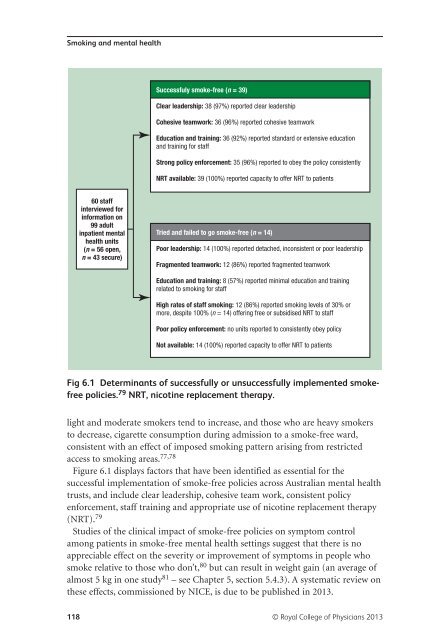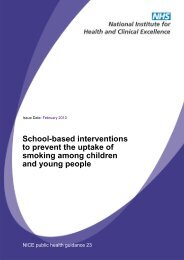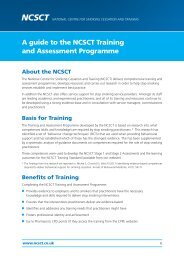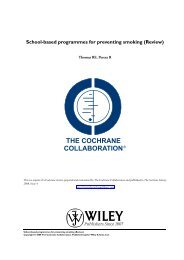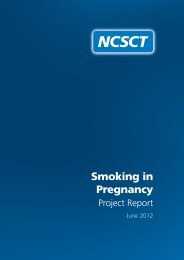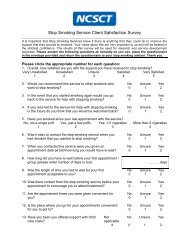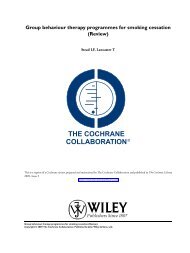Smoking and mental health - NCSCT
Smoking and mental health - NCSCT
Smoking and mental health - NCSCT
Create successful ePaper yourself
Turn your PDF publications into a flip-book with our unique Google optimized e-Paper software.
<strong>Smoking</strong> <strong>and</strong> <strong>mental</strong> <strong>health</strong><br />
Successfuly smoke-free (n = 39)<br />
Clear leadership: 38 (97%) reported clear leadership<br />
Cohesive teamwork: 36 (96%) reported cohesive teamwork<br />
Education <strong>and</strong> training: 36 (92%) reported st<strong>and</strong>ard or extensive education<br />
<strong>and</strong> training for staff<br />
Strong policy enforcement: 35 (96%) reported to obey the policy consistently<br />
NRT available: 39 (100%) reported capacity to offer NRT to patients<br />
60 staff<br />
interviewed for<br />
information on<br />
99 adult<br />
inpatient <strong>mental</strong><br />
<strong>health</strong> units<br />
(n = 56 open,<br />
n = 43 secure)<br />
Tried <strong>and</strong> failed to go smoke-free (n = 14)<br />
Poor leadership: 14 (100%) reported detached, inconsistent or poor leadership<br />
Fragmented teamwork: 12 (86%) reported fragmented teamwork<br />
Education <strong>and</strong> training: 8 (57%) reported minimal education <strong>and</strong> training<br />
related to smoking for staff<br />
High rates of staff smoking: 12 (86%) reported smoking levels of 30% or<br />
more, despite 100% (n = 14) offering free or subsidised NRT to staff<br />
Poor policy enforcement: no units reported to consistently obey policy<br />
Not available: 14 (100%) reported capacity to offer NRT to patients<br />
Fig 6.1 Determinants of successfully or unsuccessfully implemented smokefree<br />
policies. 79 NRT, nicotine replacement therapy.<br />
light <strong>and</strong> moderate smokers tend to increase, <strong>and</strong> those who are heavy smokers<br />
to decrease, cigarette consumption during admission to a smoke-free ward,<br />
consistent with an effect of imposed smoking pattern arising from restricted<br />
access to smoking areas. 77,78<br />
Figure 6.1 displays factors that have been identified as essential for the<br />
successful implementation of smoke-free policies across Australian <strong>mental</strong> <strong>health</strong><br />
trusts, <strong>and</strong> include clear leadership, cohesive team work, consistent policy<br />
enforcement, staff training <strong>and</strong> appropriate use of nicotine replacement therapy<br />
(NRT). 79<br />
Studies of the clinical impact of smoke-free policies on symptom control<br />
among patients in smoke-free <strong>mental</strong> <strong>health</strong> settings suggest that there is no<br />
appreciable effect on the severity or improvement of symptoms in people who<br />
smoke relative to those who don’t, 80 but can result in weight gain (an average of<br />
almost 5 kg in one study 81 – see Chapter 5, section 5.4.3). A systematic review on<br />
these effects, commissioned by NICE, is due to be published in 2013.<br />
118 © Royal College of Physicians 2013


